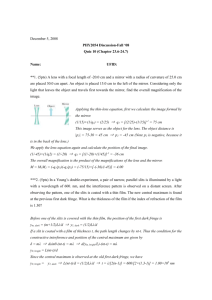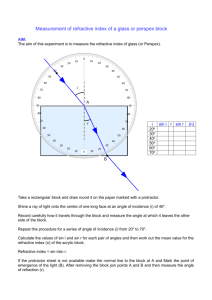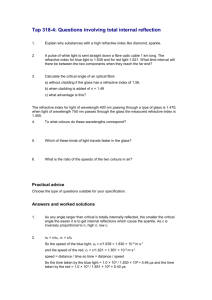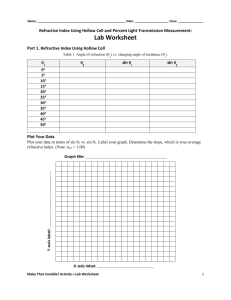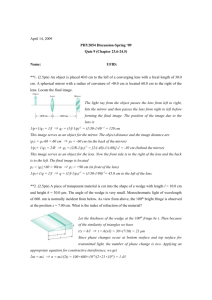Lecture Review
advertisement
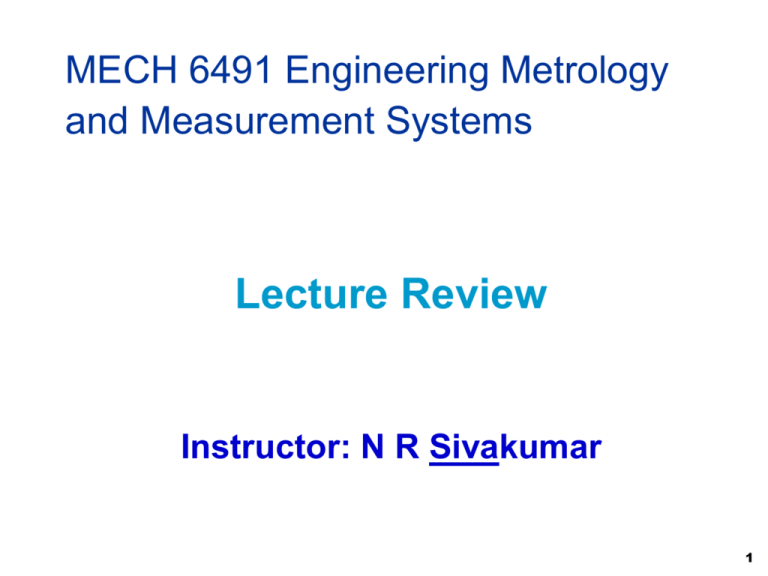
MECH 6491 Engineering Metrology and Measurement Systems Lecture Review Instructor: N R Sivakumar 1 Outline EXAM 3 hours 100marks 30 MCQ (1 Mark each) 30marks 10 T or F (1 Mark each) 10marks 10 short answers (3 marks each) 30marks 6 problems (5 marks each) 30marks Weightage towards final grade 50% SOME EXAMPLE PROBLEMS 2 1. If sunlight entering at an angle A° to water surface gets reflected as a polarized light, what angle would A° be? (Refractive index of water is 1.33) n1 sin p n2 sin 2 2 90o p n1 sin p n2 cos p tan p n2 n1 Brewster’s Law 1.33 tan p 1 tan 1 1.33 53.06 2. A Michelson interferometer using light of wavelength l has been adjusted to produce a bright spot at the center of the interference pattern. Mirror M1 is then moved distance l toward the beam splitter while M2 is moved distance l away from the beam splitter. How many bright-dark-bright fringe shifts are seen? 2 shifts when mirror 1 moves by l and 2 shifts when mirror 2 moves by l. so total is 4 3. Light with a wavelength of l is used as a source in a double slit experiment. What do you see, on a distant screen, at a point where the light from the bottom slit and top slit have a path length difference of 5 l? at a point where the light from the bottom slit and top slit have a path length difference of 5 l we will see 5th order bright fringe 4. In the figure below, a piston of automobile cylinder is given. Using the worst case analysis identify the maximum and minimum limit sizes of the piston stroke. You have to use these relations to get the max and min and find the worst case. Try. The solution though is For Minimum Piston Stroke 0.9146 and 1.0449 For Maximum Piston Stroke 3.9223 and 4.0533 5. In the figure below, shaft and housing assembly is shown. Calculate the maximum and minimum clearance possible based on the dimensions given in the table. I did not give the dimensions, so cannot be solved 6. A 4.0-cm tall light bulb is placed at a distance of 45.7 cm from a convex lens having a focal length of 15.2 cm. Determine the image distance and the image size. Also give a note about what type of image that is formed 1/15.2 = 1/45.7 + 1/x X = 22.8 M = 22.8/45.7 = 0.498 Image size = 1.99cm From the calculations in this problem it can be concluded that if a 4.0-cm tall object is placed 45.7 cm from a double convex lens having a focal length of 15.2 cm, then the real image will be inverted, 1.99cm tall and located 22.8 cm from the lens. 7. What will be the image distance, size and type if the same object was placed at a distance of 35.5 cm from a diverging lens having a focal length of -12.2 cm. -1/12.2 = 1/35.5 + 1/x X = -9.08 M = 9.08/35.5 = 0.255 Image size = 1.02cm From the calculations in this problem it can be concluded that if a 4.0-cm tall object is placed 35.5 cm from a diverging lens having a focal length of 12.2 cm, then the image will be upright, 1.02-cm tall and located 9.08 cm from the lens on the object's side (virtual). 8. If velocities of the mirror and object as shown are V, and 2V, find the velocity of the image. (Clue: you can use the squares as movment as 1 unit per t seconds, and calculate the velocity of image in terms of V) V 2V . Object, mirror and image of the object after t seconds are shown in the figure below. We find the velocity of image using this picture. V 2V As you can see on the picture given above, image of the object change 5 unit distance, if we say V to 1unit change in t seconds, velocity of the image becomes 5V. 9. Focal point of the concave mirror given below is 120 cm. An object having length 8 cm is placed at 60 cm away from the mirror. Find the location and height of the image. 1/120 = 1/60 + 1/x X = -120 M = 120/60 = 2 Image size = 16cm From the calculations in this problem it can be concluded that if a 8.0-cm tall object is placed 60 cm from a concave having a focal length of 120 cm, then the virtual image will be upright, 16-cm tall and located 120 cm from the mirror on the other side. 10. Find the velocity of the light in a medium having refractive index n=2 Refractive index n is ratio of velocities n = c/v where c is velocity of light in vaccum (3X108m/s) and v is the velocity of light in the medium So 2 = c/v, or v = c/2 so 1.5X108m/s 11. If mirror M2 in the Michelson interferometer at right is moved through 0.300 mm in one direction, a shift of 900 bright fringes occurs. What is the wavelength of the light producing the fringe pattern? One shift of fringes occurs for every change in the path length of λ. Consequently, a shift of 900 fringes corresponds to a change in the path length of 900λ. For an interferometer the path length difference is 2L1 – 2L2 so 2L= 900λ. Or 2 x 300 = 900 λ. So λ = 667nm 12. In Thomas Young’s experiment red laser light through a double slit; the slit spacing is 0.125 mm. The interference is projected on a screen 10.72 m away. The distance from the 3rd antinodal bright spots on either sides of the pattern to is 33.9 cm apart. What is the wavelength of the light. M = 6, Ym = 33.9cm D = 10.72m d = .125mm Using this we can find l l = .339X.125e-3 /6 X 10.72 = 658.8 nm Beware of units 13. Green laser (λ = 532 nm) is passed through the slits separated by a distance of 45. and the interference pattern is projected onto a screen 9.85 m away. Determine the distance between the central bright spot and the fourth bright spot. M = 4, l= 532nm D = 9.85m d = .45 Using this we can find Ym = 4 X 532e-9 X 9.85 / 45e-6 = 0.4658m or 46.6cm Beware of units 14. A diffraction grating with 12000 lines per cm separates a bright line at 24.5°. What is the wavelength of the light? The separation between slits d on the grating is 1/12,000. Using l = dsin , we can find l = 1/12000sin24.5° l = 3.4557e-7m or l = 345.6nm Beware of units 15. In the figure, the light enters from air at an angle of 30° to the normal, find out the angles of refraction in each of the interfaces. (If each section is 25mm thick, what would be horizontal displacement of light at the exit compared to the incident light). Use snells law n1sin1 = n2sin2 So 2 = sin-1(n1/n2sin1) Change 2 to 1 as you move down Air - flint glass: 18° Flint glass - water: 22° Water - diamond: 12° Diamond - zirconium: 13° Cubic zirconium - air: 30° Total variation is 29mm 16. An optical fiber is designed to guide a 400nm laser. The refractive indices of the core and cladding are 1.5 and 1.35 respectively. n of air which surrounds the fiber is 1. a) Calculate the NA of the fiber? b) Calculate acceptance angle of the fiber? NA N 0 Sin a n12 n22 NA 1.52 1.352 0.65 NA N 0 Sin a a sin 1 ( NA / N air ) a sin 1 0.65 40.83 Total Internal refl’n Problem Diffraction Problem In the Young double slit experiment, is it possible to see interference maxima when the distance between slits is smaller than the wavelength of light? Explain Need: d sin = m l If l>d => sin = m l / d then l/d>1 so sin > 1 It is not possible Fiber Optics Problem The refractive indices of core and cladding materials of a optical fibre are 1.48 and 1.45, respectively. Calculate: (i) numerical aperture, (ii) acceptance angle Let the refractive index of core, n1 = 1.48 and the refractive index of cladding , n2 = 1.45 1.Numerical aperture (NA) 2.Let θ0 be the acceptance angle PROBLEM: A diffraction grating contains 4820 lines/cm and is used with blue light (l = 470 nm). What is the highest order bright fringe that can be seen with this grating? sinq = ml/d The maximum sinq can be is 1, so 1 = ml/d m = d/l = 1/(4820 lines/cm)(100 cm/m)(470nm)(1´10-9 m/nm) = 4.4 So the maximum is 4th order fringe.
